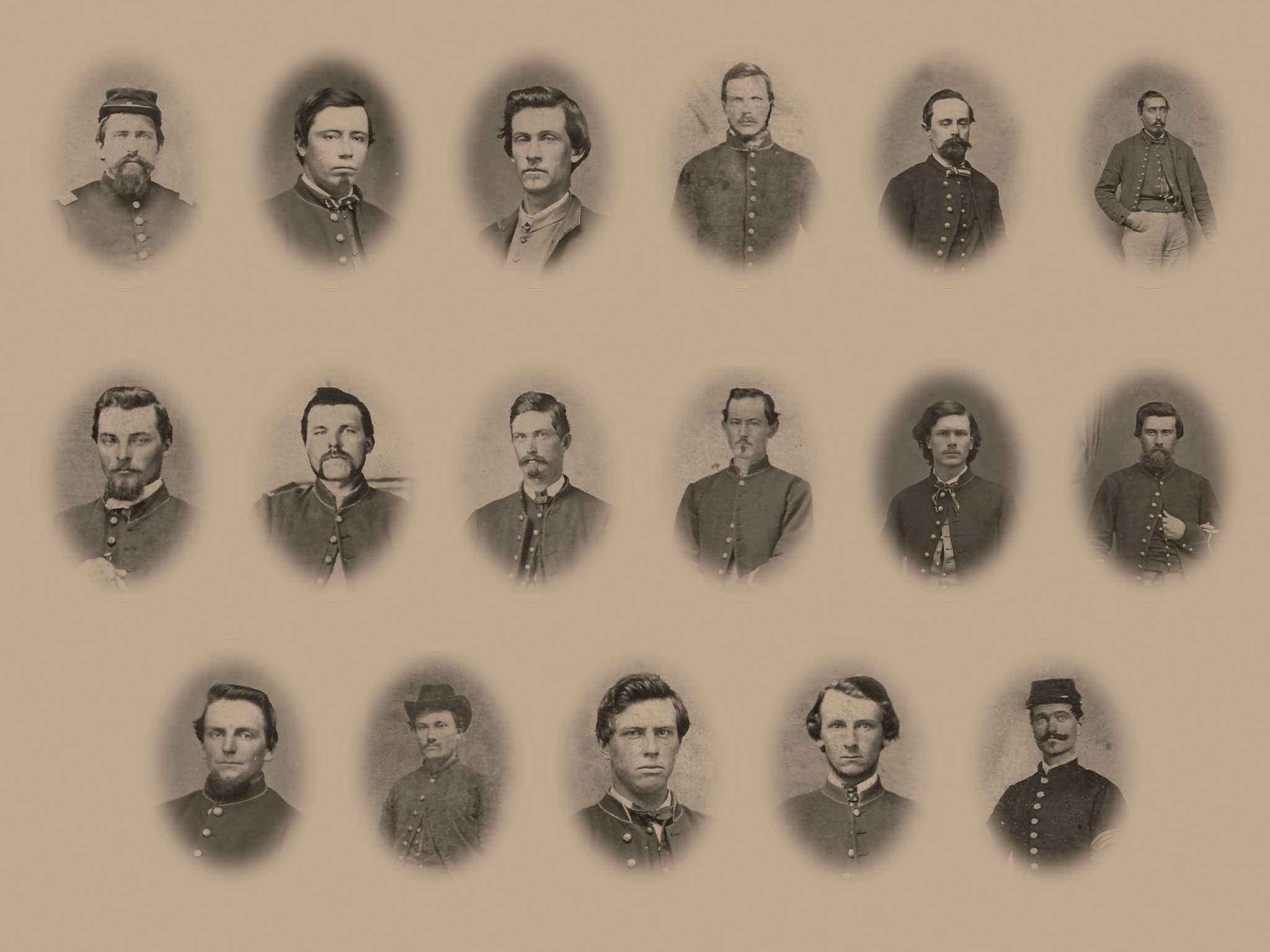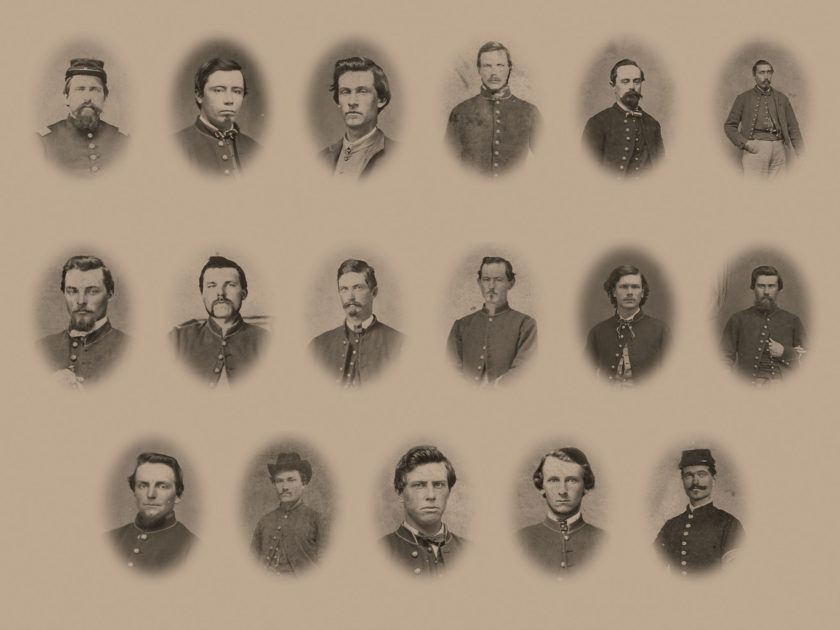By Jim Hennessey
When the first company of volunteers left Bloomington, Ill., in April 1861, it included several students and a professor from the local Illinois Normal College. Charles Hovey, the director of the fledgling school, was concerned that fervent enlistment would seriously diminish his student body. In a hastily called meeting with the boys, he persuaded them to finish the term and promised that afterward they could enlist as a group and that he, Hovey, would go with them. He also sanctioned the creation of a student military company, the “Normal Rifles,” and engaged a drillmaster. However, the ardent patriotism of Illinois very quickly fulfilled the state’s quota, and by the time that the “Rifles” held their final parade in early July no new companies were being accepted by the state.
Companies comprised of college students were found in many regiments, both north and south: the Wabash College students of Lew Wallace’s Indiana Zouaves; The Hiram College boys of the 42nd Ohio; the “University Greys” of the 11th Mississippi and the “Liberty Hall Volunteers” from Washington College (now Washington & Lee) of the 4th Virginia Infantry. Hovey had a grander scheme however, as he envisioned an entire regiment organized around his college and its personnel.
Taking his proposal to Washington in late July, Hovey was in the throng of civilians that followed the army out to Manassas and, in the course of the battle picked up and carried an abandoned musket. Although he had been rebuffed by the authorities, who believed that the war would be over in 90 days, the debacle at Bull Run disabused the government of the notion that the war would be a brief affair. After a personal meeting with President Abraham Lincoln, Hovey was authorized to return to Illinois to raise his “Educational Regiment,” with himself as its colonel. The regiment was accepted by the War Department direct as the “Normal Regiment, of teachers, pupils and young men of sterling character and education,” but was to be received through the state government as an Illinois regiment.

Hovey reassembled the “Normal Rifles,” and dispatched many of them to return to their home counties to find recruits. The ranks of Company B were filled through the efforts of three student members of the “Rifles;” Moses Morgan of DuPage County, C. Judson Gill from Toulon in Stark County, and E. Aaron Gove of LaSalle County. In late August, after convening the volunteers in Bloomington, the companies moved on to Camp Butler in Springfield. In less than a full month after Manassas, the “Schoolteacher’s Regiment” was organized and equipped, and primed for service. Appropriately, the schoolteachers of Chicago adopted the 33rd and provided it with battle flags.
Unlike in the East where the major contending armies jockeyed back and forth within an arena confined to the 180 miles between Richmond and Gettysburg, the 33rd ranged far and wide during its four years’ service. From the baptism of fire at Fredericktown, Mo., until its assault of Spanish Fort in Mobile, Ala., the regiment campaigned in Arkansas, Texas and Mississippi, figuring prominently in the preliminary battles and Siege of Vicksburg. The regiment was discharged December 1865, eight months after Appomattox.
This small carte de visite album contains images of soldiers of Company B of the 33rd. All of the photos are late war, but each of the individuals was present at the rendezvous in Bloomington in August 1861. All were veterans in length of service although three of them did not choose to officially “veteranize” when the regiment did so in 1864. Those who elected to become “Veteran Volunteers” earned a furlough to Bloomington and the right to wear the distinctive sleeve chevron seen in their portraits. On the occasion of the reenlistment, one of the men wrote:
“Farewell to home, farewell to kindredwe have pledged ourselves for three years morewe will each be in at the death of treasonor perish in the 13th Army Corps”
The contingent from Toulon, Stark County, originally recruited by Normal student C. Justin Gill, is represented in the album by five images. Nelson Gill, younger brother of Justin, rose through the ranks from sergeant to captain of Company B. An adventurer, he had joined the California gold-seekers before the war. In the post-war period, he served a term in the Mississippi State Legislature from Holly Springs. Gill died in San Bernardino, Ca., in 1903. Walter T. Hall, a farmer from Toulon, left at the expiration of his original enlistment with the rank of sergeant. He contributed the sketch of Company B in the 1902 book, History of the Thirty Third Regiment Illinois Veteran Volunteer Infantry. Charles E. Shinn, seen here as a corporal, mustered out as a sergeant, and is remembered in the History as “a good soldier, always faithful to his trust, generous to a fault.” Edward H. Ingraham was the brother of the regiment’s sergeant major, Duncan G. Ingraham. A trove of 130 letters by the Ingraham brothers is in the collection of the Chicago Historical Society. William Mayo, born in New York, was a 30-year-old farmer from Princeville when he enlisted.
DuPage County is also represented by the images of five of its sons. Charles Andrews of Downers Grove chose not to “veteranize,” but fully served out his enlistment and transferred to the 99th Illinois Infantry. Luther J. Clark, a farmer from Bloomingdale, was the regimental bugler. He died in Mexico, N.Y., on Oct. 25, 1912. German-born Frederick Holtzkampf is remembered as having a fine tenor singing voice. His diary, written in German, is in the Chicago Historical Society collection. He died in Chicago on June 22, 1903, and is buried in Waldheim Cemetery, Forest Park, Ill. Bradford Wakeman, a 19-year-old horticulturist from Addison enlisted as a fifer, and rose to fife major. He wears the chevrons of a principle musician. A creative writer, Wakeman made several contributions to the History, notably the narrative poem “Over The Hills To Vicksburg.” He died at Chebanse, Ill., on Dec. 21, 1912. George Fetzler, a Philadelphia-born hack driver from Cass, figured in an amusing account of foraging in the company of his comrade Tom Hall. The pair were apprehended by a cavalry patrol while returning to camp in a pilfered carriage with Fetzler wearing a plug hat and a long tailed coat with confiscated brandy and silver forks in the pockets. Fetzler left the 33rd as a corporal and served by transfer in the 99th Illinois.
The LaSalle County contingent recruited by Normal student E. Aaron Gove is represented by two images in the album. Charles Hebbard and Laurence Jacobson were among the 17 men from Rutland in Company B. Cpl. Hebbard was remembered as an animal lover with a string of pet squirrels, coons and birds. He was wounded at Vicksburg. Laurence Jacobson was discharged for disability at Vicksburg from disease contracted in the line of duty in October 1865.
These contingents from Dupage, LaSalle and Stark Counties provided the majority of the recruits for Company B . However, in addition more than 23 Counties were represented by individual soldiers.
Cpl. Martin Stark and Sgt. Wallace Johnson hailed from Wheatland, Will County. Both were regarded as good soldiers.
Harrison W. Ellis, a Virginia-born and 20-year-old farmer from Mason County, served with the regiment for the entire term of its service.
Lucius Rew from Macoupin County enlisted as a private in Company B, and was commissioned first lieutenant of Company G. He was detailed as a provost marshal in the Freedman’s Bureau at Corinth, Miss. A comment in History pertaining to Rew’s transfer stated, “To take a non-commissioned officer from one company and make him a commissioned officer in another company, and retain the good feeling that should exist between officers and enlisted men in that company, is a hard thing to do. Rew was a level-headed, clear sighted man. He by kind and just treatment won their respect.”
Sgt. Charles H. Keyes of Springfield suffered a shoulder wound at Spanish Fort in Mobile, Ala., that troubled him for the remainder of his life. The combat that he was most remembered for however, was his single-handed thwarting of an attempt by three deserters from the 18th New York Cavalry to cross the bridge he was guarding. “His stockless rifle attested the vigorous defense.” Sgt. Keyes died on July 10, 1921 in Glendale, Ariz.
In summation of the service of Company B, the regimental historian noted, “For some unexplainable reason Fate was very kind to B Company,” and added, “The words ‘killed in action’ were never written next to the name of any man borne on its rolls. Several of its men were seriously or fatally wounded, but none killed. This did not come from any neglect of duty. B Company did its work in a satisfactory manner in every place to which it was assigned.”
Jim Hennessey is a longtime subscriber and contributor to MI. A Chicago-born painter and retired college art professor, he is a member of the Company of Military Historians and the creator of 10 uniform plates for the Company’s Military Uniforms in America series, which reflect his interested in Zouaves and Illinois in the Civil War.
SPREAD THE WORD: We encourage you to share this story on social media and elsewhere to educate and raise awareness. If you wish to use any image on this page for another purpose, please request permission.
LEARN MORE about Military Images, America’s only magazine dedicated to showcasing, interpreting and preserving Civil War portrait photography.
VISIT OUR STORE to subscribe, renew a subscription, and more.

